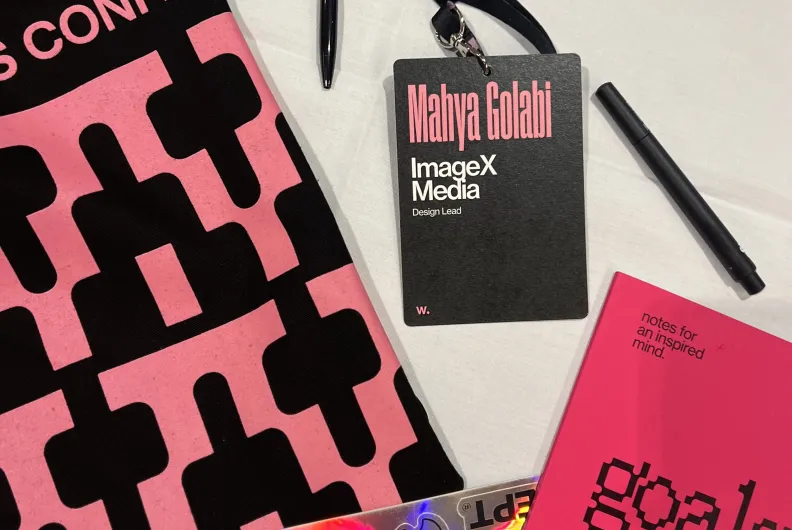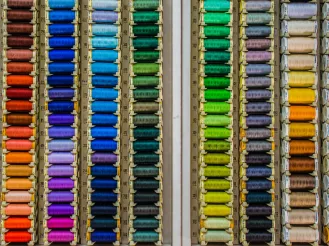Inspiration from the 2023 Digital Thinkers Conference: Interview with Mahya Golabi, Lead Designer
Mahya Golabi, ImageX’s Lead Designer, trailblazer, creative, and mother, sat down with Tess Souvlos to discuss her first time attending the 2023 Digital Thinkers Conference by Awwwards, what inspires her work, and her thoughts on AI in design.
Tess: Can you share a little bit about your experience at the 2023 Digital Thinkers Conference in Toronto? What were your highlights?
Mahya: Sure, so Awwwards is a renowned web design and development award body. Their Digital Thinkers Conference is an annual event that brings together web designers, developers, digital agencies, and creative professionals from all around the world. This year, for the first time, it was held in North America, so I was determined to attend.
The event had some great highlights, including high-quality speakers and many networking opportunities. Because of Awwwards’ prestige, their conferences attract some of the most influential and talented professionals in the field. For example, I had the pleasure of meeting a few designers who I admire and follow on YouTube, such as Travis Neilson, Pablo Stanley, and Femke Van Schoonhoven. It was really nice to see these thought leaders live in the flesh.
I also had the chance to meet like-minded designers from companies like Amazon, Webflow, and many tech startups. I sort of forced myself to go up to different people and strike up conversation. This allowed me to seek out different crowds, gain inspiration, and learn about their design processes.
Tess: Did you find it natural to network or do you consider yourself more of an introvert? What was that like for you?
Mahya: To be honest, I consider myself an extrovert, but I kind of feel like I, along with many others, can get caught up in our day to day comforts or habits and stepping out of that is sometimes hard. Also, I think being at a conference can be a little overwhelming with the amount of people and all the activity happening. So even as an extrovert, I had to push myself. As I networked with different crowds and mingled, I made so many interesting connections and had meaningful conversations. The more I did it, the more natural it felt. It kept me present and engaged at the event.
Tess: It’s great to hear that you leveraged the opportunity to network. What commonalities did you find in speaking with several other designers?
Mahya: While I was at the conference, ImageX was in the process of migrating all of its designers from Sketch to Figma. This migration was something that was initiated, as I saw more and more designers working with it and thought that it was time that we aligned with the wider marketplace, utilizing the best tools possible for our projects.
At the conference, it was interesting to see how many other design agencies, both small and large, were also using Figma. Their struggles and successes seemed similar to ours, which was both reassuring and inspiring.I feel like we are definitely headed in the right direction.
Tess: For our non-designer readers, could you speak a little more about Figma?
Mahya: Figma is a web app for design. I feel like it really changed the way the design community works altogether. Just recently, I attended Figma’s own Config conference and it was incredible to see that 10,000 people attended in person and about 100,000 attended virtually. It’s a widely popular tool, and it’s not only for designers but for everybody - developers, Business Analysts, Project Managers, all those involved in a digital project. Figma really prioritizes their user experience and is heavily involved with their community. I think that's what really makes it stand out. Not to mention the comprehensive set of functionalities it has.
Tess: Going back to the sessions you attended, you mentioned that you got to listen to a few thought leaders. Who stood out most for you and why?
Mahya: As a designer, there were lots of sessions that resonated with me but the most memorable one was "You Deserve It" by Pablo Stanley. He took a comedic approach, exaggerating certain characteristics of designers. His intention was not to provide an accurate representation of all designers, but to entertain through satire. I love humor and consider myself a quirky person so I very much enjoyed his speaking style.
He touched on stereotypes and behaviors often associated with designers. For example, how designers often prefer expensive fonts, minimalist design, and pay great attention to detail. He humorously portrayed designers as individuals who trust their instincts, thrive in chaotic environments, and are always on the lookout for new design tools and trends. Guilty as charged! He also talked about some negative traits like designers taking credit for others' work, bluffing their way through meetings, and shifting blame onto team members.
In the end, his takeaway was completely different from what he spoke about and presented, which was that he really wants designers to be leaders, claim a seat at the table (no matter how scary), engage in important decision-making, and have confidence through all uncertainties. It challenged me and made me think. I loved it so much that I went up to him right after the talk, totally fan-girled and asked him if he could share his keynote with me.
Tess: That’s great! As a design lead, what’s your advice on claiming a seat at the table?
Mahya: Design is very subjective. Each person has a different perspective, a different view. As a designer, I think it's very important to separate yourself from your design. This can be hard for junior designers or people who have less experience. When you’re emotionally attached to your art or creative output, it’s hard to hear critiques or even be confident with what you're presenting. But I think the most important thing is that whatever you are putting out there, be sure that it’s your absolute best. If it’s the best you can do, you’re more able to feel confident about it and can present it with more conviction.
When you’re first starting out, sure there is that level of uncertainty like, can I claim that seat? Am I worthy of it? But I can tell you that after 10 years of working in the industry, having that confidence really comes with experience. And in the meantime, you have to know that whatever you're producing is your best work. The more you feel like you are the expert at what you do, the more you can lead like one.
When I first started my career, design was an afterthought in the tech industry. Digital projects like websites or apps were development led. I was the only designer among a team of 15-20 developers. It took a lot of patience, time, and me advocating for design in order to get to where I am now.
Tess: Were there any design trends that piqued your interest at the conference? Do you think they could be relevant to your current or future projects?
Mahya: These days, no tech or design conference is complete without a discussion on Artificial Intelligence. I loved Travis Neilson’s session because he didn’t talk about how AI is going to take over but rather how designers have a responsibility to shape the future of machines, and emphasized the need for a UX/AI designer who will humanize the future.
He encouraged designers to develop a point of view, speak up in meetings, attend conferences, and become thought leaders in the AI/UX space. What will set designers apart going forward is their openness and willingness to learn about AI instead of being afraid of it.
Tess: What do you think is the future of design?
Mahya: I personally believe that AI will revolutionize the future of design. It will help designers work faster and smarter by automating repetitive tasks and providing valuable insights.
AI algorithms will generate design ideas, optimize user experiences, and assist in data-driven decision-making. While they currently don't always produce the most effective results, we will eventually get there. With AI's ability to analyze vast amounts of data, designers will create more personalized and impactful designs that cater to user preferences.
Overall, AI will enhance creativity, efficiency, and the quality of digital experiences in design. It will amplify our creativity.
Tess: Is there anything we haven’t touched that you wanted to share?
Mahya: As designers, we can get caught up in our busy day-to-day lives. Despite this, we should always push ourselves to cultivate time to either attend talks or conferences, read papers, and/or listen to podcasts. This way, we can discover new ideas and inspiration, learn from industry experts, collaborate, and stay informed about the world we live in. To all the aspiring designers, as Pablo Stanley encouraged, go out there and claim your seat.
From what we’ve gathered, Mahya’s experience at the Digital Thinkers Conference really allowed her to broaden her horizons. She not only sought a lot of inspiration from different sessions and her peers, but also made some meaningful connections and got the opportunity to travel to a different city. We are grateful to her for sitting down with us and hope that her interview inspires more designers of all levels to stay curious, continually learn, and attend more design conferences.



